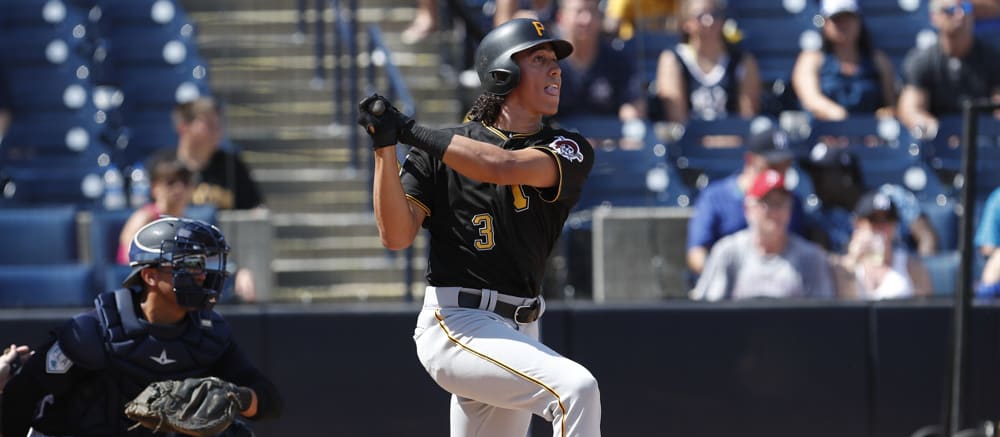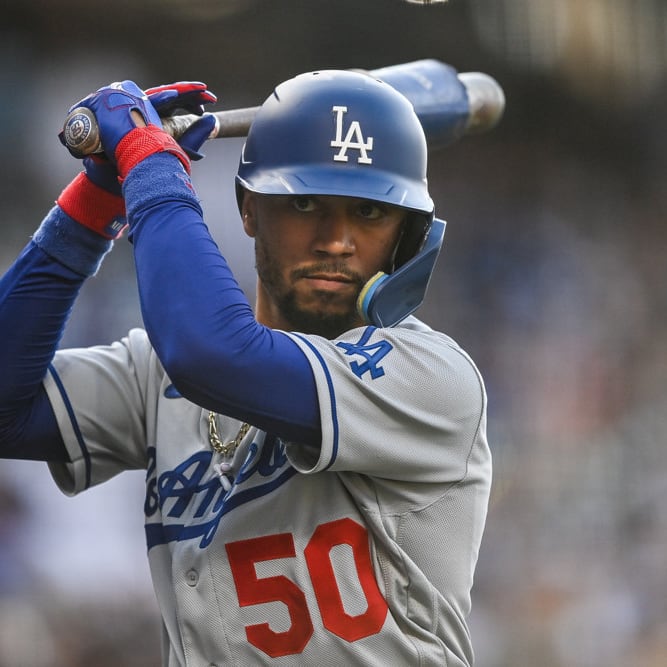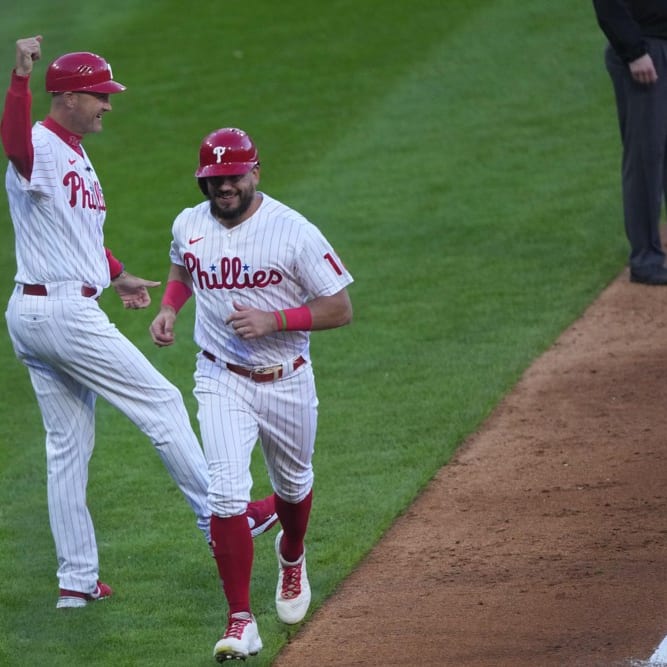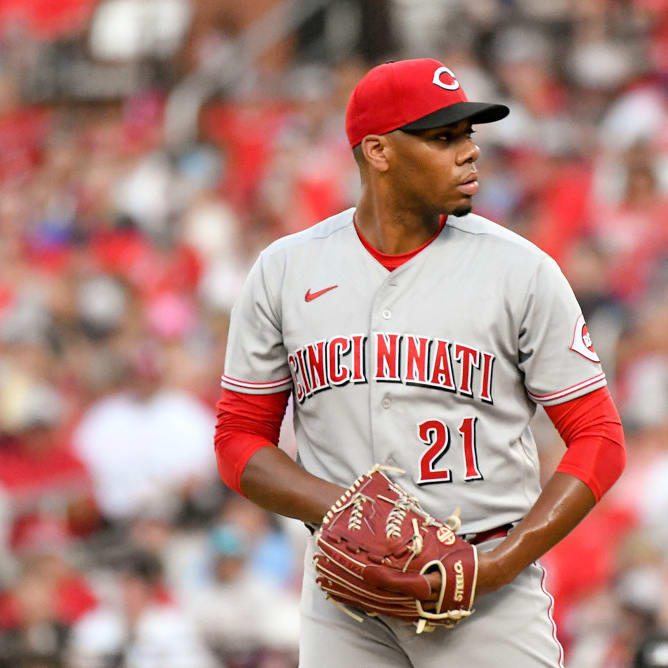This article is part of our Farm Futures series.
We all have our biases when it comes to valuing prospects for dynasty leagues. I don't mind rostering pitching prospects, young or old. In fact, that's an area where I have had a lot of recent success in dynasty leagues. I also don't mind rostering catchers -- I'd prefer not to, of course, but if the best available prospect in a league is a catcher, I will add him. You should know by now that I definitely don't mind rostering 16- and 17-year-old hitters. Basically, I'll roster any type of prospect if I think they have a chance to be a quality big leaguer.
Some of you approach things a little differently. I know this, because you tell me. Many of you don't want pitching prospects. Many of you don't want "low-ceiling" players, which in itself is something of a false reality -- Francisco Lindor, Alex Bregman and Jose Ramirez were all seen as "low-ceiling" prospects at one point in their development. Others don't have the patience to roster a guy who's three years away from the majors. We can agree to disagree on these practices.
However, there is one type of prospect that every dynasty-league manager is interested in: hitters who are close to the big leagues.
For this reason, the pool of hitting prospects who are at Double-A or Triple-A and are both desirable and unowned in your competitive dynasty league is very shallow or perhaps even non-existent. What I will attempt to do in this piece
We all have our biases when it comes to valuing prospects for dynasty leagues. I don't mind rostering pitching prospects, young or old. In fact, that's an area where I have had a lot of recent success in dynasty leagues. I also don't mind rostering catchers -- I'd prefer not to, of course, but if the best available prospect in a league is a catcher, I will add him. You should know by now that I definitely don't mind rostering 16- and 17-year-old hitters. Basically, I'll roster any type of prospect if I think they have a chance to be a quality big leaguer.
Some of you approach things a little differently. I know this, because you tell me. Many of you don't want pitching prospects. Many of you don't want "low-ceiling" players, which in itself is something of a false reality -- Francisco Lindor, Alex Bregman and Jose Ramirez were all seen as "low-ceiling" prospects at one point in their development. Others don't have the patience to roster a guy who's three years away from the majors. We can agree to disagree on these practices.
However, there is one type of prospect that every dynasty-league manager is interested in: hitters who are close to the big leagues.
For this reason, the pool of hitting prospects who are at Double-A or Triple-A and are both desirable and unowned in your competitive dynasty league is very shallow or perhaps even non-existent. What I will attempt to do in this piece is highlight the upper-level hitting prospects whose hot starts could portend a breakout season. Given the minuscule sample, these players are not shooting up my rankings, but realistically, if you wait until we have a large enough sample, the guys who are for real will be long gone.
As with last week's piece, I will work my way down from players who might be available in shallow leagues to players who could be available in deep leagues. (Apologies to those of you who want me to advise you on leagues where 1,000+ prospects are rostered -- it's close to a full-time job for me to just give you a really good top 400.)
Cole Tucker, SS, Pirates
Tucker's batting average will come down, but that doesn't mean we're not seeing legit skills growth. His 23.7 LD% would be easily the best mark of his minor-league career, and his 28.6 IFFB% should experience positive regression. I'm buying Tucker as a .265 hitter who hits 12-15 HR and steals 20-25 bases while providing plus defense. He is Pittsburgh's clear shortstop of the future. Will this front office decide to aggressively promote players all of a sudden? I have my doubts, but if I were sitting in the big chair, it would be difficult to keep my team's best shortstop (Tucker) and third baseman (Ke'Bryan Hayes) at Triple-A all season.
Jorge Mateo, SS, A's
As with Tucker, Mateo's batting average is unsustainably high, but he cut his strikeout rate from 27.3 percent at Triple-A last year to 17.9 percent this year. He is carrying a whopping 39.0 LD%, which will regress, but still showcases the amount of quality contact he has been making. We don't need Mateo to hit .270 in the majors. We just need him to hit around .250. If he does that, his defense and baserunning will all add up to a quality everyday player. Marcus Semien and Jurickson Profar are under team control through the 2020 season, so Mateo is a luxury piece for the A's. However, if he proves over a long stretch this season that he has made significant improvements over last year, he should firmly pass Franklin Barreto on the organizational depth chart as the next man up in that middle infield.
Jake Fraley, OF, Mariners
Everyone knows I love Fraley, so he was obviously going to show up here. His age (turns 24 on May 25) may scare some off, but he was selected out of LSU in 2016 and missed a lot of time due to injuries early in his pro career, so the fact that he is "only" at Double-A shouldn't be concerning. I absolutely love the quality of his contact -- he barrels everything and uses the whole field. He is also sporting a career-best 13.7 BB% in the early going. His 70-grade speed allows him to be a plus defender in center field, and he should eventually push Mallex Smith to a bench role, perhaps later this summer.
Josh Lowe, OF, Rays
I tried to add Lowe in RDI and TDGX over the weekend and went 1-for-2 on those adds. He sports a .458 BABIP and 28.9 K%, so his true-talent batting average is closer to .242 than the .342 he is currently hitting. However, he is now a couple years into the transition from the infield to center field, and could end up being a plus defender out there. That will be crucial if he is to eventually crack this talented big-league roster. Lowe's career-best 30.8 LD% will come down, he also has a career-low 30.8 GB%, so there might be some skills growth reflected here. Save for his full-season debut in 2017, Lowe has logged walk rates over 10 percent at every stop, so while his AVG may be league average or a little below average, his OBP could be above average, which could earn him some looks as the Rays' leadoff hitter. While he hits from the left side, Lowe uses the whole field, so he should be shift proof. Here are some true statements:
- Josh was the 13th overall pick in 2016 and his older brother, Nate Lowe, was the 390th overall pick in 2016.
- Nate is two and a half years older than Josh, but is only one level ahead of him in the minors.
- Josh plays a premium, up-the-middle position, while Nate is limited to 1B and DH.
They are both quality prospects, but one was universally rostered coming into the season, while the other -- the one with 60-grade speed and 20-steal upside -- was widely available in leagues where around 300 prospects are rostered. That gap, which was probably too big before the season, is closing.
Cavan Biggio, OF/2B, Blue Jays
I don't want to overreact to what Biggio has done through two weeks, but so far he is doing all of the things he wasn't doing the last couple years that had me low on him, relative to his surface production.
| K% | BB% | LD% | Pull% | Oppo% | |
| 2018 | 26.3 | 17.8 | 17.3 | 51.0 | 24.2 |
| 2019 | 15.2 | 17.4 | 32.3 | 48.4 | 35.5 |
There is no questioning his ability to bang out homers to the pull side, but last year's version of Biggio profiled as a whiff machine and a hitter who would be susceptible to the shift. If he holds these huge contact gains and continues use the opposite field at a solid clip, he would all of a sudden look like a much more complete offensive player. He can't compete with Bo Bichette as a long-term dynasty asset, but Biggio will probably beat Bichette to the majors if he keeps this up.
Dylan Carlson, OF, Cardinals
Here is how the six youngest hitters at Double-A are faring so far:
| Age (Years.Days) | K% | BB% | wRC+ | |
| Luis Garcia | 18.336 | 17.0 | 1.9 | 53 |
| Isaac Paredes | 20.058 | 16.2 | 8.1 | 124 |
| Drew Waters | 20.108 | 26.5 | 8.2 | 148 |
| Cristian Pache | 20.149 | 29.5 | 4.5 | 186 |
| Hudson Potts | 20.171 | 34.6 | 11.5 | 42 |
| Dylan Carlson | 20.176 | 13.6 | 8.5 | 118 |
Carlson isn't particularly toolsy -- his only tools that are clearly above average are on the defensive side of the ball -- which is why he is ranked lower than the rest of these guys on the top 400. However, he has average power and average speed, and could end up getting on base at an above-average clip. There's also a chance that he develops plus power. That's by no means a star, but he could develop into a Brandon Nimmo type in a perfect scenario.
Sean Murphy, C, A's
Don't focus on Murphy's unsustainable .405 AVG, focus on the fact that he is walking 13.6 percent of the time, up from 8.0 percent at Double-A last year. He will probably strike out at a fairly high clip when he gets to the big leagues, but he might just do enough to be a league-average hitter, which is a major accomplishment for a catcher. I expect him to be Oakland's primary catcher by June or July.
Myles Straw, SS/OF, Astros
The Astros are trying out Straw at shortstop early this season, given the organizational logjam in the outfield, which has the potential to be great for his fantasy value. Instead of competing with guys like Kyle Tucker for a shot on the big-league roster, all Straw needs to do is prove to be better than Aledmys Diaz, which shouldn't be too difficult. Hitting for a decent average will be easy for Straw, given his 70-grade speed and superb contact skills, but what we really needed from him this season is more extra-base hits -- he has primarily lived off poking singles to right field in past seasons. He has answered the bell thus far, with six extra-base hits in 12 games at Triple-A this year after logging just 13 extra-base hits in 66 games at Triple-A last year. Straw may never be more than a bench piece for the Astros, but if he ever saw semi-regular time in a utility role, he could steal 30 bases in just 400 plate appearances.
Bryan Reynolds, OF, Pirates
Coming into this year, Reynolds' career-high ISO was .188 from short-season ball in 2016. He currently sports an unsustainable .349 figure, and is over halfway to matching the seven HR he hit in 88 games at Double-A last year. There is a lot of noise in this data (28.6 HR/FB%), but hitting for at least 18-20 HR pop will be critical if Reynolds is to profile in left field. He is an average runner and has already stolen three bases (on five attempts). It's not a sexy profile from a tools perspective, but Reynolds has legit pedigree and has hit at least .302 with at least a 122 wRC+ in every league he has played in -- feats that few minor-league hitters can claim.
Will Smith, C, Dodgers
I haven't been very high on Smith for many of the same reasons I haven't been high on Biggio, but so far he has made all the adjustments on my to-do list for him at the plate. We shouldn't focus on what he did in a brief taste of Triple-A last year, but here's a comparison of what he did at Double-A in 2018 compared to this year's hot start:
| K% | BB% | LD% | Pull% | Oppo% | |
| 2018 (AA) | 24.4 | 11.7 | 23.4 | 56.3 | 20.8 |
| 2019 (AAA) | 16.3 | 23.3 | 32.0 | 44.0 | 24.0 |
Again, it's very early, so I'm not going to overreact on my top 400, but if even some of these improvements are somewhat legitimate, it changes the equation with Smith, who is probably already a better player than Russell Martin.
Nicky Lopez, SS/2B, Royals
Lopez's K:BB ratios have been the primary driver of his dynasty-league intrigue to date, but his current 1:4 K:BB in 44 PA is absurd, even by his standards. His 2.3 K% is the best mark at Triple-A. He also happens to be an above-average runner who could be a plus defender at second base. His current .205 ISO would also shatter his previous career high of .147, but his batted-ball profile does not support those power gains. I don't think I'm going out on a limb saying Lopez is better than Chris Owings, so I'd expect him to be up in the majors sooner than later. Once up, he probably won't move the needle much, but could finish the year with 10-12 steals and a decent average.
Dom Thompson-Williams, OF, Mariners
Unlike Fraley, Thompson-Williams doesn't have a good excuse for being at Double-A for his age-24 season; he legitimately needed that much time to get ready for this level. However, he has impact tools (plus power, above-average speed), and has shown impressive plate discipline in the early going. His walk rate is up from 8.3 percent at High-A to 11.6 percent at Double-A, and his strikeout rate is down from 25.3 percent to 16.3 percent. After going 17/17 last year, he will probably go 20/20 this season if this is the new normal.
Buddy Reed, OF, Padres
Reed posted a 24 wRC+ in 43 games at Double-A last year as a 23-year-old, so my expectations were low for him in a return trip to the Texas League. However, he has cut his strikeout rate (32.3% to 26.2%), upped his walk rate (6.2% to 8.2%) and line drive rate (19.7% to 21.1%), and is using the opposite field much more (25.0% to 35.9%). He will probably be 25 by the time he reaches the majors, but has 70-grade speed and enough raw power to bang out double-digit home runs over a full season. A likely outcome would be Keon Broxton (especially when factoring in his plus center-field defense), but there's a chance Reed ends up being a bit better than that.
C.J. Chatham, 2B/SS, Red Sox
Chatham almost has half as many doubles (six) in nine games at Double-A as he did in 95 games at High-A last year (14). Clearing the fence remains an issue, but he has upped his flyball rate from 23.9 percent to 46.4 percent, so it is clearly a point of emphasis. He is also using the whole field a lot more while cutting his strikeout rate to an elite 15.4 percent. Michael Chavis has more offensive impact potential, but when factoring in Chatham's ability to capably play both middle-infield spots, he might be the better real-life prospect at this point. He has missed a lot of time due to injury, and at 24 years old, he may only need a couple more months at Double-A before he gets bumped up to Triple-A.
Daniel Johnson, OF, Indians
The top piece the Indians got back in the November trade that sent Yan Gomes to the Nationals, Johnson has the kind of athleticism and tools (above-average raw power, double-plus speed) that fantasy managers crave, but there have always been questions about his ability to hit enough to be more than a fourth outfielder. The two big changes thus far have been huge spikes to his walk rate (5.9% last year at Double-A, 14.3% this year at Double-A) and his flyball rate (37.2% last year, 65.5% this year). He won't maintain that level of improvement in those two areas, but as long as some of those gains hold, he starts to look a lot more interesting. Given his experience at Double-A, a promotion to Triple-A should be right around the corner. That will be the true test for the 23-year-old.
Tommy Edman, 2B/SS, Cardinals
Everything about Edman brings back horrific memories of the Tony La Russa Cardinals. A gritty, overachieving 5-foot-10 middle infielder named Tommy? Come on. That said, this guy's got a chance to turn into an everyday player. He sports a 10.9 K% and is hitting .347 despite a 33.3 IFFB% that is sure to come down. Edman has above-average speed that he likes to put to use on the bases. From a skills standpoint, I think he is Nicky Lopez with less name value and more stolen-base upside, although his path to playing time is much more difficult to envision.
Lucas Erceg, 3B, Brewers
The Pacific Coast League is a great place to hit, and this is Erceg's first exposure to that reality. It's also the first time his walk rate has been north of 10 percent -- he has eight walks in 43 PA (18.6 BB%). Additionally, he sports a career-high 48.1 FB%, which is important, as he looks to more regularly tap into his best offensive tool: above-average raw power. I would have cut Erceg loose a year ago in most dynasty leagues, but it's possible I wrote him off too soon.
Andrew Velazquez, OF/SS, Rays
Velazquez found new life as a prospect after adding center field to the list of positions he can play in 2017. He can still handle shortstop in a pinch, but he could be an elite outfield defender. This equates to nice player to add in September when rosters expand, but he could be more than that if he can contribute with the bat. He has not taken a walk in 10 games to start the season, but has trimmed his strikeout rate from 26.9 percent at Triple-A in 2018 to 12.5 percent thus far. He has also upped his line drive rate from 21.6 percent to 29.3 percent. Velazquez's plus speed and likely dual-position eligibility are the main selling points in dynasty leagues, but he needs to continue to hit to have a chance to break in as a semi-regular player on a loaded Rays roster.
Andretty Cordero, 2B/1B/3B, Rangers
Prior to this year, Cordero had only started games at first base or third base, but he is getting some work at second base in the early going. This makes sense, as his bat is probably a little light for a corner, especially first base. He sports a career-best 8.3 BB% and an elite 12.5 K%. Most importantly, Cordero has cut his groundball rate from 50.1 percent at High-A to 41.7 percent at Double-A. His bat will have to carry him, but this could be a 2019 pop-up guy.
Derek Hill, OF, Tigers
Hill is on the short list of minor-league hitters whose development has suffered most from injuries. The No. 23 overall pick in 2014, Hill has showcased legitimate 80-grade center-field defense when healthy, which is essentially a guaranteed ticket to the big leagues. He will need to hit at least a little, however, in order to be more than a Jarrod Dyson-esque defensive/pinch-running specialist. So far, Hill has improved his strikeout rate (28.5% at High-A, 21.4% at Double-A) and line drive rate (18.3% at High-A, 23.1% at Double-A) while getting to much more pop (.278 ISO) than he's shown in past seasons. I'm not optimistic about him keeping all of this up -- I expected him to fall on his face a little in his first exposure to Double-A pitching -- but if he does, we're looking at an everyday center fielder who would steal 25-plus bases pretty easily.
Travis Demeritte, OF, Braves
Demeritte has been teasing dynasty-league managers with his power/speed combo for a half decade, but his contact issues have resulted in him falling off the radar in RDI-sized leagues. He struck out 28.3 percent of the time at Double-A last year, but is down to 16.7 percent Triple-A in the early going. He also has a 34.5 LD%, which is easily a career high. Demeritte moved to the outfield last season and has primarily played right field this year, which makes sense, given the Braves' glut of quality infielders. This is probably just noise in a small sample, but it's worth tracking for a few more weeks.
Dawel Lugo, 2B/3B, Tigers
Lugo isn't a good baseball player in the traditional sense. He's kind of a poor man's Willie Calhoun, although not quite that bad defensively. However, the Tigers can't be too picky when deciding who to give at-bats to this year. Last year he walked 1.7 percent of the time at Triple-A, and this year that figure is up to 10.9 percent. He has also upped his line drive rate from 20.9 percent to 29.4 percent. Again, I'm not a big fan, but he should get another look in the majors fairly soon.
Omar Estevez, 2B, Dodgers
When the Dodgers signed Estevez out of Cuba in 2015, he was seen as a player with a very advanced hit tool. Despite that aspect of the scouting report, the highest AVG Estevez logged before this year was a .278 mark in a repeat trip to High-A last year. Obviously his .388 mark is unsustainable, but his 10.9 K% is less than half the 23.9 K% he logged in 2018. He has always posted impressive line drive rates, but his current 31.8% mark is easily a career best. It's still not a very exciting profile, particularly because Estevez is not much of a threat on the bases, but he is firmly back on my radar as one of the younger hitters at Double-A.
Jorge Ona, OF, Padres
Another Cuban signee who failed to impress in his first couple seasons, Ona was OK (115 wRC+) at Low-A in 2017, but struggled in the California League last year (87 wRC+). He continues to strike out more than we would like (28.6 K%) at Double-A, but is finally walking over 10 percent of the time (12.2 BB%). He is also using the whole field more and riding a career-best 25.0 LD%. We know he has big raw power, but he will need to maintain these approach/batted-ball gains if he is to develop into a regular in an outfield corner.
Rylan Bannon, 3B, Orioles
Bannon was rostered in many dynasty leagues in the middle of last season, but then dropped in many of those leagues after his production fell off following the trade from the Dodgers to the Orioles (he was the third piece in the Manny Machado trade). He seems to have rebounded in many ways to the player he was at High-A with the Dodgers, and is also hitting more line drives (25.7%) than ever. Bannon will likely need another month or two at Double-A, but should spend most of this summer at Triple-A if he keeps this up.










